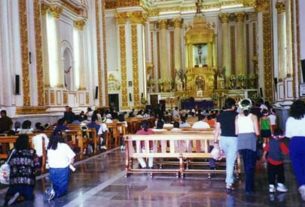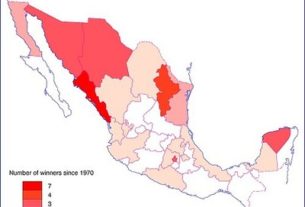The fall of the Aztec Empire and capture of its ruler Cuauhtémoc (1521), left Spanish conquistador Hernán Cortés in charge of a vast and largely unfamiliar land. By 1522 his sovereign, Carlos V, had bestowed upon him the title Governor and Captain General of Nueva España (New Spain). Cortés promptly founded the Ciudad de Mexico on the ruins of the once-majestic Tenochtitlán, building a European-style colonial capital with the rubble left from razed Aztec pyramids, temples and palaces.
Soon Cortés dispatched his lieutenants in every direction to explore and conquer more territory where they searched for gold and other riches, as well as possible routes for reaching Asia by sea. Cortés himself set off south towards Honduras on an expedition that would last nearly two years. In order to deter defiant Aztecs from rising up during his absence, he took Cuauhtémoc along as a hostage. But in the course of the perilous venture, in an apparent fit of paranoia, he ordered the last Aztec emperor to be tried and summarily hanged on grounds of treason.
Meanwhile, political intrigues were afoot among Cortés’ enemies in both Spain and the colonies. In 1524 Carlos V had formed the Council of the Indies to administer its colonies in the western hemisphere. Three years later Nueva España’s first Audiencia was appointed. In Spain the functions of these panels of oidores (judges) were limited to judicial matters, whereas in overseeing the colonies they wielded wide executive and legislative powers.
His absolute authority thus suspended, Cortés was ordered to return to Spain in the spring of 1528. Intent on securing the confidence of the Spanish King, he bore a host of new world riches as gifts for the monarch. These included not only gold and jade, but also exotic flora and fauna, ranging from cacao, a coveted Aztec delicacy, to brightly hued parrots, as well as a retinue of Indian nobles.
Cortés’ tactics were at least partially successful. Denied the full command over New Spain that he desired, Cortés nonetheless returned to Mexico in 1530 with the title Marquis of the Valley of Oaxaca. He retired to Cuernavaca to take charge of a vast estate, covering some 25,000 square miles, granted to him by the king. As his rivals continued to create troubles, Cortés sailed back to Spain, hoping to regain the King’s good graces anew. Disillusioned at his failure to overcome growing alienation from the Crown, the great conquistador fell sick and died in 1547. A few years later his remains were returned to Mexico and laid to rest in the Niño Jesus Chapel near the Zócalo, Mexico City’s main square.
Control of the first Audiencia had fallen into the hands of one of Cortés’ most ardent enemies, the notorious Nuño de Guzmán. Ruthless and corrupt, he kept news of his dark deeds from reaching the Spanish Court by intercepting correspondence from his critics. When word did finally reach the King, he appointed a new Audiencia. to take over. Once Guzmán realized the tide was turning against him, he gathered a band of mercenaries and set off on an expedition to the western hinterlands. Cutting a bloody path of death and devastation wherever he went, Guzmán’s violent rampage lasted several years before, under orders of the second Audiencia, he was arrested and sent back to Spain in irons.
Finally, in 1535, Antonio de Mendoza was appointed as the first of 61 viceroys who were to rule over Nueva España for the next three centuries. As the King’s deputy, the Viceroy served as chief of all military, political and administrative officers. During Mendoza’s 15-year rule the dimensions of colonial territories continued to grow, eventually expanding south to Honduras, north to what is now Kansas and as far east as today’s New Orleans. Nueva España was divided into regions, many of which were designated with names from the homeland. Nueva Galicia was founded in 1548; Nueva Vizcaya in 1562; Nuevo León in 1579. Nuevo México was established in 1583. Spain’s horizons were broadened even further as explorations along the Pacific coast led to the opening of maritime gateways to Asia. As far north as British Columbia, Canada, there are many spanish topographical place names.
Territorial expansion led to the exploitation of natural riches, particularly gold, silver and other mineral resources. The yield from Mexico’s mines doubled the world supply of silver in less than two centuries. With this new wealth colonial cities sprang up far and wide. Talented Indian stonemasons, who had once crafted temples and pyramids, were put to work building chapels, cathedrals, monasteries and convents, as well as administrative palaces and grand residences, for their new Spanish masters. The skill of those native hands remains visible in the 16th century structures that still grace Mexico today, from the nation’s capital, to Queretaro, San Miguel de Allende, Guanajuato, Morelia, Guadalajara, Zacatecas and the quintessential colonial city of Puebla.



